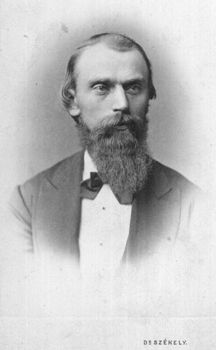This is an old revision of this page, as edited by Magnus Manske (talk | contribs) at 12:17, 3 July 2012 (ref cleanup). The present address (URL) is a permanent link to this revision, which may differ significantly from the current revision.
Revision as of 12:17, 3 July 2012 by Magnus Manske (talk | contribs) (ref cleanup)(diff) ← Previous revision | Latest revision (diff) | Newer revision → (diff)| Gustavus Detlef Hinrichs | |
|---|---|
 | |
| Born | (1836-12-02)2 December 1836 Lunden, Holstein, Germany |
| Died | 14 February 1923(1923-02-14) (aged 86) St. Louis Missouri United States |
| Nationality | German, American |
| Alma mater | University of Copenhagen |
| Known for | creation of a periodic table of elements Derecho |
| Scientific career | |
| Institutions | State University of Iowa, St. Louis University |
Gustavus Detlef Hinrichs (2 December 1836 – 14 February 1923) was a chemist who published his findings on periodic laws within the chemical elements well before Dmitri Mendeleev or Lothar Meyer.
Life
Hinrichs was born in Lunden, Holstein, which belonged at that time to Denmark. He attended the polytechnic school and the University of Copenhagen. During his schooling he published several articles and books, including descriptions of the magnetic field of earth and its interaction with the aether. He graduated in 1860, between the First Schleswig War and the Second Schleswig War. He emigrated later that year to the United States, settling initially in Davenport, Iowa where he taught school, then in Iowa City, Iowa. In 1863 he was made professor of Natural Philosophy, Chemistry, and Modern Languages at the University of Iowa. Hinrichs founded the first state weather and crop service in the United States. He was the head of the Iowa Weather Service until 1886. He was first to identify the straight-line storm phenomenon known as the Derecho. He stayed at that University until he had to leave his office in 1886 when he was fired by the state Board of Regents because of disputes with the University president and other faculty. He became professor at the St. Louis University in 1889 and stayed there until his retirement in 1907.
Periodic law
Hinrichs is one of the discoverers of the periodic laws which are the basis for the periodic table of elements. Although his contribution is not as important as that of Mendeleev or Lothar Meyer, he stated his ideas as early as 1855 and published his book Programme der Atomechanik in 1867. His periodic table had the form of a spiral and the elements where placed into the structure according to their atomic mass. Hinrichs also postulated theory on the cause of the periodicity within the chemical elements. His theory was based on the composition of the elements out of smaller Panatome. The Trigonoides are the nonmetals made from regular triangles, while the metallic Tetragonoides were made from squares. Algebraic formulas of how to mix squares and triangles gave the periodic laws. His "controversial ideas and colorful personality" proved to be an obstacle to the spread of his ideas.
References
- ^ Wolf, Ray. "A Brief History of Gustavus Hinrichs, Discoverer of the DERECHO". NOAA. Retrieved 3 July 2012.
- ^ Zapffe, Carl A. (1969). "Gustavus Hinrichs, Precursor of Mendeleev". Isis. 60 (4): 461–476. doi:10.1086/350537. JSTOR 229106.
-
 Wilson, J. G.; Fiske, J., eds. (1892). Appletons' Cyclopædia of American Biography. New York: D. Appleton.
Wilson, J. G.; Fiske, J., eds. (1892). Appletons' Cyclopædia of American Biography. New York: D. Appleton. {{cite encyclopedia}}: Missing or empty|title=(help) - Biography and papers at the University of Iowa Libraries. Retrieved 2009-11-06.
- ^ Kauffman, George B. (1969). "American forerunners of the periodic law". Journal of Chemical Education: 128.
- Eric Scerri, The Periodic Table, Its Story and Its Significance, Oxford University Press, 2007, p. 86-92.